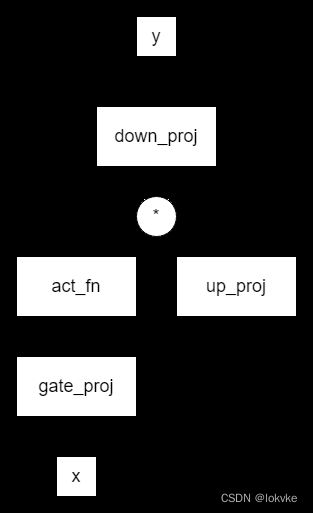Llama模型结构解析(源码阅读)
目录
- 1. LlamaModel整体结构流程图
- 2. LlamaRMSNorm
- 3. LlamaMLP
- 4. LlamaRotaryEmbedding
- 参考资料:
https://zhuanlan.zhihu.com/p/636784644
https://spaces.ac.cn/archives/8265 ——《Transformer升级之路:2、博采众长的旋转式位置编码》
前言:本次阅读代码位置,在transformers库底下的modeling_llama.py,具体位置在:transformers/models/llama/modeling_llama.py,如下图所示:
1. LlamaModel整体结构流程图
2. LlamaRMSNorm
- 代码如下
class LlamaRMSNorm(nn.Module):
def __init__(self, hidden_size, eps=1e-6):
"""
LlamaRMSNorm is equivalent to T5LayerNorm
"""
super().__init__()
self.weight = nn.Parameter(torch.ones(hidden_size))
self.variance_epsilon = eps
def forward(self, hidden_states):
input_dtype = hidden_states.dtype
variance = hidden_states.to(torch.float32).pow(2).mean(-1, keepdim=True)
hidden_states = hidden_states * torch.rsqrt(variance + self.variance_epsilon)
return (self.weight * hidden_states).to(input_dtype)
-
RMSNorm的公式如下所示:
x i 1 n ∑ i = 1 n x i 2 + e p s ∗ w e i g h t i \frac{x_i}{\sqrt{\frac{1}{n}\sum\limits_{i=1}^{n}{x_i}^2 + eps}} * weight_i n1i=1∑nxi2+epsxi∗weighti
3. LlamaMLP
- 代码如下:
class LlamaMLP(nn.Module):
def __init__(
self,
hidden_size: int,
intermediate_size: int,
hidden_act: str,
):
super().__init__()
self.gate_proj = nn.Linear(hidden_size, intermediate_size, bias=False)
self.down_proj = nn.Linear(intermediate_size, hidden_size, bias=False)
self.up_proj = nn.Linear(hidden_size, intermediate_size, bias=False)
self.act_fn = ACT2FN[hidden_act]
def forward(self, x):
return self.down_proj(self.act_fn(self.gate_proj(x)) * self.up_proj(x))
-
其中输入为x,输出为y
-
代码中intermediate_size一般比hidden_size大,我们通过在jupyter notebook中打印Llama-13B的模型,可以看到如下所示:

-
总结:MLP模块就是几个nn.Linear的组合
4. LlamaRotaryEmbedding
- 代码如下
class LlamaRotaryEmbedding(torch.nn.Module):
def __init__(self, dim, max_position_embeddings=2048, base=10000, device=None):
super().__init__()
inv_freq = 1.0 / (base ** (torch.arange(0, dim, 2).float().to(device) / dim))
self.register_buffer("inv_freq", inv_freq)
# Build here to make `torch.jit.trace` work.
self.max_seq_len_cached = max_position_embeddings
t = torch.arange(self.max_seq_len_cached, device=self.inv_freq.device, dtype=self.inv_freq.dtype)
freqs = torch.einsum("i,j->ij", t, self.inv_freq)
# Different from paper, but it uses a different permutation in order to obtain the same calculation
emb = torch.cat((freqs, freqs), dim=-1)
self.register_buffer("cos_cached", emb.cos()[None, None, :, :], persistent=False)
self.register_buffer("sin_cached", emb.sin()[None, None, :, :], persistent=False)
def forward(self, x, seq_len=None):
# x: [bs, num_attention_heads, seq_len, head_size]
# This `if` block is unlikely to be run after we build sin/cos in `__init__`. Keep the logic here just in case.
if seq_len > self.max_seq_len_cached:
self.max_seq_len_cached = seq_len
t = torch.arange(self.max_seq_len_cached, device=x.device, dtype=self.inv_freq.dtype)
freqs = torch.einsum("i,j->ij", t, self.inv_freq)
# Different from paper, but it uses a different permutation in order to obtain the same calculation
emb = torch.cat((freqs, freqs), dim=-1).to(x.device)
self.register_buffer("cos_cached", emb.cos()[None, None, :, :], persistent=False)
self.register_buffer("sin_cached", emb.sin()[None, None, :, :], persistent=False)
return (
self.cos_cached[:, :, :seq_len, ...].to(dtype=x.dtype),
self.sin_cached[:, :, :seq_len, ...].to(dtype=x.dtype),
)
- 具体的使用,还调用了另外两个函数,如下所示:
def rotate_half(x):
"""Rotates half the hidden dims of the input."""
x1 = x[..., : x.shape[-1] // 2]
x2 = x[..., x.shape[-1] // 2 :]
return torch.cat((-x2, x1), dim=-1)
def apply_rotary_pos_emb(q, k, cos, sin, position_ids):
# The first two dimensions of cos and sin are always 1, so we can `squeeze` them.
cos = cos.squeeze(1).squeeze(0) # [seq_len, dim]
sin = sin.squeeze(1).squeeze(0) # [seq_len, dim]
cos = cos[position_ids].unsqueeze(1) # [bs, 1, seq_len, dim]
sin = sin[position_ids].unsqueeze(1) # [bs, 1, seq_len, dim]
q_embed = (q * cos) + (rotate_half(q) * sin)
k_embed = (k * cos) + (rotate_half(k) * sin)
return q_embed, k_embed
-
总结:RoPE就是在attention计算时,K跟Q做内积之前,先给各自注入位置信息。
结束。




